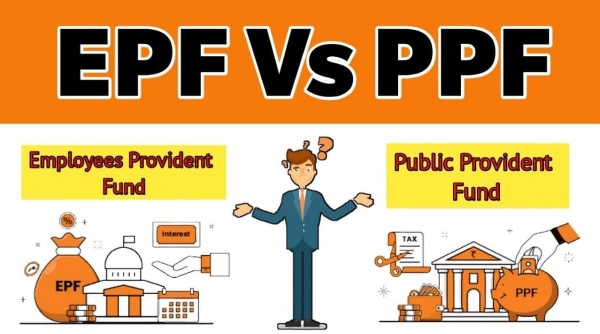EPF vs PPF Comparison: Retirement plans supported by the government provide individuals with diverse avenues to invest in their future financial stability. Among these options, the Employee Provident Fund (EPF) and Public Provident Fund (PPF) stand out as favoured choices for individuals aiming to fortify their retirement funds. Each scheme comes with distinct withdrawal regulations, eligibility conditions, and associated risk factors that necessitate careful consideration.
Both are government-managed savings schemes tailored for employees in the organised sector as well as the general public. Despite their apparent similarities and shared objective of establishing a long-term corpus for investors, numerous distinctions set them apart. Variances in interest rates, tenure, tax benefits, and other aspects characterise these savings instruments differently.
Before making any investments, it’s crucial to understand the specifics of both EPF and PPF schemes. EPF is exclusively available to salaried employees in the private sector, whereas PPF is accessible to individuals across both organised and unorganised sectors. Your decision between EPF and PPF should align with your long-term financial objectives, risk tolerance, and investment purpose.
EPF:
The EPF is an obligatory retirement savings scheme wherein both the employer and the employee make contributions. These contributions are predetermined based on the salary structure. While partial withdrawals are permitted, the complete corpus is accessible only upon reaching retirement age. The scheme also offers tax advantages. EPF is particularly well-suited for salaried individuals seeking a retirement-centric savings avenue.
- Mandatory for salaried employees: Both employer and employee contribute 12% of basic salary + dearness allowance.
- Higher interest rate: Currently 8.25%, but can change.
- Limited liquidity: Difficult to withdraw funds before retirement (except under specific conditions).
- Tax benefits: Contribution eligible for tax deduction under Section 80C.
- Managed by EPFO: Government-backed but exposure to the equity market through 15% investment.
PPF:
PPF enables individuals to bolster their retirement funds while concurrently lowering their tax burden. With a minimum tenure of 15 years, PPF permits partial withdrawals after a specified duration. This investment avenue caters to both salaried and non-salaried individuals seeking a degree of flexibility in their long-term savings strategy.
- Voluntary scheme: Open to all Indian citizens and NRIs.
- Lower interest rate: Currently 7.1%, which can change if the government does it.
- Limited liquidity: Restricted withdrawals after 5 years, full withdrawal at maturity (15 years).
- Tax benefits: Contributions, interest, and maturity amounts are tax-free.
- Managed directly by the government: Offers higher safety compared to EPF.
EPF vs PPF: Comparison
Investment amount: In PPF an individual can start with a minimum of Rs 500 and the maximum is Rs 1,50,000 in a financial year. On the other hand for EPF, a compulsory contribution of 12 % of salary, and DA is made. It can be increased voluntarily.
Tenure: PPF is for 15 years and is extendable after that for a period of 5 years. The EPF account can only be closed after retirement or after a subscriber remains unemployed for more than two months.
Tax benefit: For PPF investments tax benefit is available under Section 80C of the Income Tax Act. The maturity amount is also exempted from tax. The contribution to EPF attracts tax benefit while withdrawal from EPF account before completion of five years of employment will be taxable. The maturity amount after retirement is tax-free.
EPF vs PPF: Drawbacks
PPF
- Partial withdrawal from PPF is not permitted until five years have passed since the opening of the account. Even if you need money for an emergency or remain unemployed, you cannot withdraw from the PPF.
- Considering the 15-year maturity period, PPF comparatively offers lower interest rate compared to other savings options like Mutual funds or FDs over the same duration.
EPF
- Only salaried employees of the organisations registered with the EPFO are eligible to enroll under the scheme. Individuals who are self-employed or retired are not eligible.
- The EPF contribution is rigid and set at 12% of the employee’s basic pay and DA matched by the employer with an equal share. You may contribute more through VPF, but that can’t be less than the EPF share.
PPF vs EPF: Can You Take Both Schemes Together?
Certainly, you can concurrently enrol in both PPF and EPF schemes. There are no limitations on participating in both, and it can be a prudent strategy to diversify your retirement savings, capitalising on the distinct benefits each scheme provides.
Benefits of taking both:
- Increased retirement corpus: Combined contributions and returns in both schemes can lead to a larger retirement fund.
- Diversification: Lessens dependence on a single scheme and offers protection against potential market fluctuations in EPF.
- Flexibility: PPF offers more control over contributions and withdrawals compared to EPF.
- Tax benefits: Utilise tax deduction under Section 80C through EPF and enjoy the tax-free benefits of PPF.
Consider your income and financial goals when deciding how much to contribute to each scheme. Understand the withdrawal rules and tax implications before making any decisions. It’s always wise to consult with a financial advisor for personalised advice based on your circumstances.
Source By: news18










